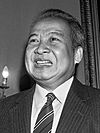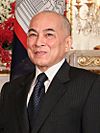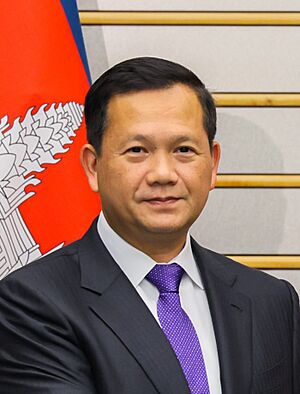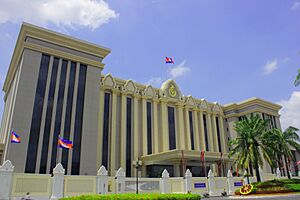Prime Minister of Cambodia facts for kids
Quick facts for kids Prime Minister of the Kingdom of Cambodia |
|
|---|---|

|
|

Seal of the Cabinet of Cambodia
|
|
|
|
| Style |
|
| Member of |
|
| Reports to | National Assembly |
| Residence | Peace Palace |
| Seat | Phnom Penh |
| Nominator | Largest political party in parliament |
| Appointer | Monarch by royal decree |
| Term length | Five years, renewable, no term limits |
| Constituting instrument | Constitution of Cambodia |
| Formation | 18 March 1945 |
| First holder | Norodom Sihanouk |
| Deputy | Deputy Prime Minister |
| Salary | 10,000,000 KHR/US$ 2,490 per month |
The Prime Minister of Cambodia is the main leader of the government in Cambodia. This person is like the chief executive, leading the group of ministers called the Cabinet. The Prime Minister is also a member of the country's parliament.
The King chooses the Prime Minister for a five-year term. Since 1945, many people have held this important job. The current Prime Minister, since August 22, 2023, is Hun Manet.
Contents
History of Cambodia's Prime Ministers
The role of Prime Minister first started in March 1945. At that time, Cambodia was under French rule. King Norodom Sihanouk became the first Prime Minister. He worked with Japan and declared Cambodia's independence from France. His government lasted until August 1945.
After Japan surrendered, France returned to Cambodia. In 1946, France allowed political parties and elections for the first time. The Democratic Party was very strong in the 1940s. Later, the Sangkum party became the only legal party from 1955 to 1970.
In 1993, Cambodia became a constitutional monarchy again. This means the country has a King, but the Prime Minister and parliament run the government. Prince Norodom Ranariddh was the first Prime Minister chosen in a democratic election. This election was supported by the United Nations.
For a short time in 1993, Hun Sen and Prince Norodom Ranariddh shared the role of Prime Minister. But in 1997, Hun Sen took full control. Since the 1998 election, Hun Sen and his party, the Cambodian People's Party (CPP), have won every election. Unlike some other countries, Cambodia's Prime Minister serves a set five-year term. They cannot call for early elections.
How the Prime Minister is Chosen
To become Prime Minister, a person must first be a member of parliament. The parliament then votes, and the person needs a majority of votes to be chosen. After that, a special ceremony takes place at the Royal Palace.
The chosen Prime Minister takes an oath in front of the King and religious leaders. Then, they announce their team of ministers, called the Cabinet. A new government must be formed within 60 days after an election. The Prime Minister also gets help from several Deputy Prime Ministers.
In July 2022, a change was made to the constitution. This change removed the need for a majority vote in parliament to elect the Prime Minister. If the Prime Minister leaves office or passes away, a temporary Prime Minister is appointed.
The Prime Minister's Office
The main workplace for the Prime Minister is the Peace Palace in Phnom Penh. It was opened in 2010. However, the Prime Minister lives in their own private home.
What the Prime Minister Does
The Prime Minister has many important duties and powers, which are set out in Cambodia's Constitution. Here are some of the key things the Prime Minister does:
- Leading the Government: The Prime Minister leads the Council of Ministers, which is the main government body.
- Working with the King: The King appoints the Prime Minister. The King also meets with the Prime Minister and Cabinet twice a month to discuss the country's situation.
- National Safety: If the country is in danger, the King can declare a state of emergency. This needs approval from the Prime Minister and leaders of the parliament.
- Parliamentary Sessions: The Prime Minister can ask for special meetings of the National Assembly or the Senate.
- Making Laws: The Prime Minister can suggest new laws.
- Answering Questions: Members of parliament can ask the government questions. If a question is about the government's overall plan, the Prime Minister must answer it personally.
- Forming the Cabinet: After an election, the King chooses a person to form the government based on the winning party. This person, who becomes Prime Minister, then chooses other ministers.
- Collective Responsibility: All members of the government, led by the Prime Minister, are responsible to the National Assembly for the government's overall plans.
- Weekly Meetings: The Cabinet meets every week. The Prime Minister usually leads these meetings.
- Constitutional Changes: The Prime Minister can suggest changes to the Constitution.
List of Prime Ministers Since 1993
Here is a list of the Prime Ministers of Cambodia since the monarchy was brought back in 1993.
| No. | Portrait | Prime minister
(Lifespan)
|
Term of office | Political party | Mandate | Monarch
Reign
|
|||
|---|---|---|---|---|---|---|---|---|---|
| Start | End | Duration | |||||||
| 1 |  |
Norodom Ranariddh នរោត្តម រណឫទ្ធិ (1944–2021) |
24 September 1993 |
6 August 1997 |
3 years, 316 days | FUNCINPEC | 1993 | Norodom Sihanouk r. 1993 – 2004 |
|
| 2 |  |
Hun Sen ហ៊ុន សែន (born 1952) |
24 September 1993 |
30 November 1998 |
5 years, 67 days | CPP | |||
| 3 |  |
Ung Huot អ៊ឹង ហួត (born 1945) |
6 August 1997 |
30 November 1998 |
1 year, 116 days | FUNCINPEC | |||
| (2) |  |
Hun Sen ហ៊ុន សែន (born 1952) |
30 November 1998 |
22 August 2023 |
24 years, 265 days | CPP | 1998 | ||
| 2003 | |||||||||
| 2008 | |||||||||
Norodom Sihamoni r. 2004 – present |
|||||||||
| 2013 | |||||||||
| 2018 | |||||||||
| 4 |  |
Hun Manet ហ៊ុន ម៉ាណែត (born 1977) |
22 August 2023 |
Incumbent | 2 years, 122 days | CPP | 2023 | ||

Deputy Prime Ministers of Cambodia
The Deputy Prime Minister of Cambodia is a high-ranking official who helps the Prime Minister. This is the second most important position in the Cabinet. As of November 2024, there are 12 Deputy Prime Ministers working at the same time.
| Name | Appointed | Ministerial positions |
|---|---|---|
| Aun Pornmoniroth | 6 September 2018 | Minister of Economy and Finance (2013–present) |
| Vongsey Vissoth | 22 August 2023 | Minister in charge of the Office of the Council of Ministers (2023–present) |
| Sar Sokha | 22 August 2023 | Minister of Interior (2023–present) |
| Tea Seiha | 22 August 2023 | Minister of National Defence (2023–present) |
| Hangchuon Naron | 22 August 2023 | Minister of Education, Youth and Sport (2013–present) |
| Sok Chenda Sophea | 22 August 2023 | Minister of Foreign Affairs and International Cooperation (2023–2024) |
| Keut Rith | 22 August 2023 | Minister of Justice (2020–present) |
| Say Sam Al | 22 August 2023 | Minister of Land Management, Urban Planning and Construction (2023–present); Minister of Environment (2013–2023) |
| Neth Savoeun | 22 August 2023 | None |
| Sun Chanthol | 22 August 2023 | None; Minister of Public Works and Transport (2004–2008; 2016–2023); Minister of Commerce (2013–2016) |
| Hun Many | 21 February 2024 | Minister of Civil Service (2023–present) |
| Prak Sokhonn | 20 November 2024 | Minister of Foreign Affairs and International Cooperation (2024–present) |
See also
 In Spanish: Primer ministro de Camboya para niños
In Spanish: Primer ministro de Camboya para niños
- List of kings of Cambodia
- List of heads of state of Cambodia
- Cabinet of Cambodia
- Leader of the Opposition



